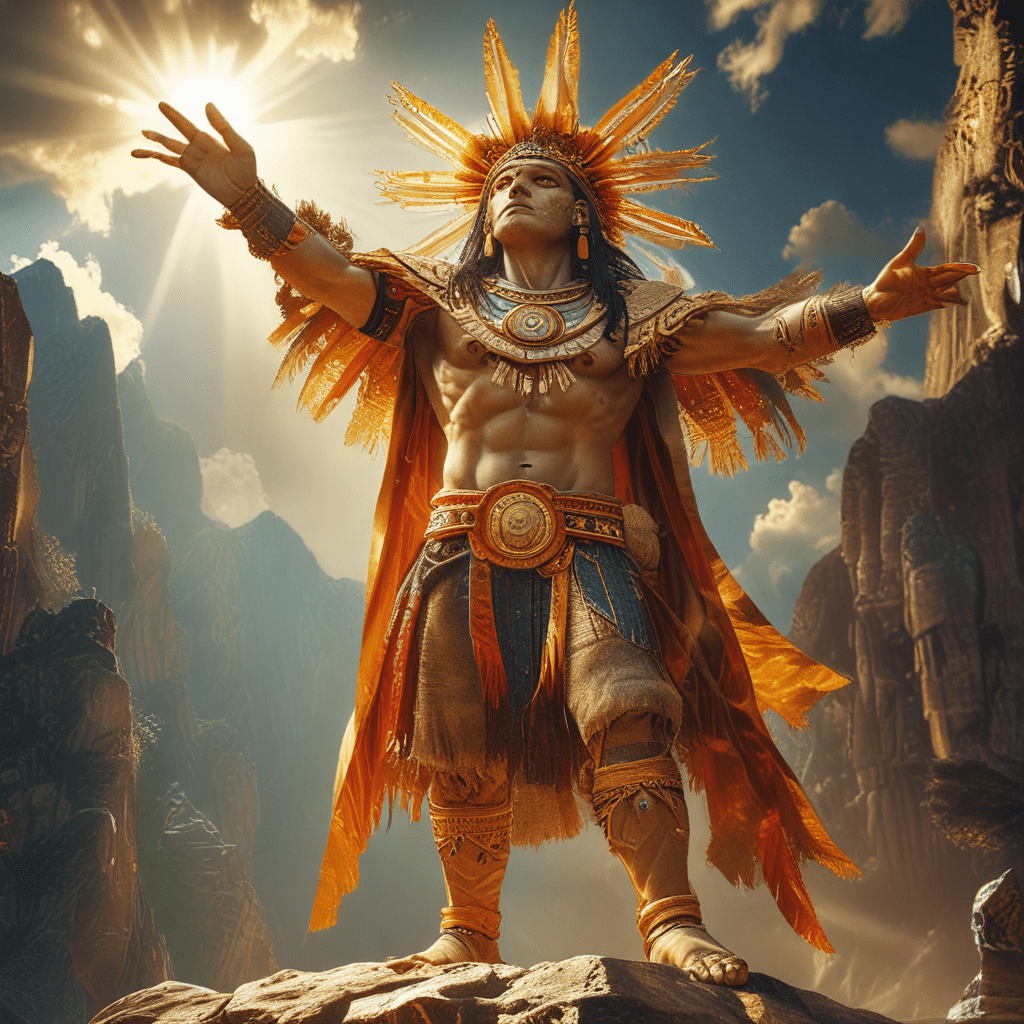Inti, the Sun God: A Symbol of Power in Incan Mythology
Introduction
In the heart of the mighty Inca Empire, where towering peaks kissed the clouds and the sun bathed the land in golden light, resided Inti, the revered Sun God. More than a celestial being, Inti embodied the very essence of life, warmth, and power, his presence woven into the fabric of Incan mythology and shaping the destiny of a civilization. As the creator god, sustainer of life, and protector of the Inca Empire, Inti reigned supreme, his influence permeating every aspect of Incan society.
Mythology of Inti
Emerging from the celestial Lake Titicaca, Inti, the radiant son of Viracocha, the supreme creator god, ascended to the heavens, bringing forth light and warmth to the world. His celestial journey across the sky, from east to west, mirrored the daily cycle of life, his presence heralding the dawn and his departure ushering in the night. Inti's celestial dance was not a solitary one, for his sister, Mama Killa, the Moon Goddess, followed in his wake, illuminating the night with her gentle glow. Together, they embodied the harmonious balance of the cosmos, their eternal dance representing the cyclical nature of life and death.
Myths and legends abound, each whispering tales of Inti's power and benevolence. One such tale recounts how Inti, disguised as a humble shepherd, descended to Earth to seek a wife. He found her in the form of Mama Occllo, the daughter of the Inca chief, and together they ascended to the heavens, becoming the divine progenitors of the Inca people. Another tale speaks of Inti's wrath, unleashed upon those who dared to defy his will, his fiery arrows raining down upon the disobedient, a stark reminder of his awesome power.
Inti as a Symbol of Power
In the celestial hierarchy of the Inca pantheon, Inti stood supreme, his position mirroring the power and authority he wielded over the earthly realm. His radiant presence, illuminating the world with life-giving warmth, was a potent symbol of his dominion over all things. The brilliance of the sun, casting away darkness and illuminating the path forward, served as a metaphor for Inti's ability to dispel ignorance and guide his people towards enlightenment.
The Inca emperors, claiming direct descent from Inti, cleverly leveraged this celestial lineage to legitimize their rule and solidify their position as divine rulers. By associating themselves with the power of the sun, they not only commanded the respect and obedience of their subjects but also reinforced their claim as divinely appointed leaders. This strategic appropriation of Inti's symbolism allowed the Inca emperors to maintain a tight grip on power, ensuring the stability and prosperity of their vast empire.
Inca art and architecture served as vibrant canvases for showcasing Inti's symbolic significance. The magnificent Temple of the Sun in Cusco, dedicated to Inti, stood as a testament to his revered status. Its golden-plated walls, shimmering under the sun's rays, mirrored the brilliance of the deity it honored. intricate carvings and motifs depicting Inti's celestial journey adorned the temple walls, further emphasizing his powerful presence. These artistic representations served not only as aesthetic expressions of devotion but also as potent reminders of Inti's omnipotence.
Theories on the Significance of Inti
Scholars have proposed various interpretations of Inti's significance in Incan society and religion. Some posit that Inti's association with agriculture played a pivotal role in shaping his prominent position within the Inca pantheon. As the provider of sunlight and warmth, essential for the growth and sustenance of crops, Inti was revered as the ultimate guarantor of agricultural success. The Inca people, heavily reliant on their agricultural prowess for survival, attributed their prosperity to Inti's benevolence, further solidifying his status as a deity of paramount importance.
Others emphasize the intricate relationship between Inti worship and the social and political structures of the Inca Empire. The cyclical nature of Inti's celestial journey, mirroring the changing seasons and agricultural cycles, provided a framework for regulating social and political life. Rituals and ceremonies held in honor of Inti served not only as expressions of religious devotion but also as opportunities for community gatherings, reinforcing social bonds and fostering a sense of collective identity. Moreover, the Inca emperors' claim of descent from Inti served to legitimize their authority and solidify their position as divine rulers, thereby ensuring the stability and prosperity of the empire.
Conclusion
Inti, the revered Sun God, stood as a central figure in Incan mythology, his power and influence deeply intertwined with the fabric of Incan society. As the creator god, sustainer of life, and protector of the Inca Empire, Inti's celestial presence permeated every aspect of Incan life. His association with light, warmth, and power served as a potent symbol of the Inca emperors' authority, while his connection to agriculture underscored his vital role in ensuring the prosperity of the empire. Though the Inca Empire eventually succumbed to the forces of conquest, the legacy of Inti worship continues to resonate within Andean cultures, reminding us of the enduring power of celestial symbolism and its profound impact on human societies.
Frequently Asked Questions
1. What were the main rituals and ceremonies held in honor of Inti?
The most prominent ceremony dedicated to Inti was Inti Raymi, the Festival of the Sun, held annually during the winter solstice. This elaborate celebration involved offerings to Inti, ritual sacrifices, and communal feasting, all culminating in a grand procession led by the Inca emperor himself. Other rituals included Capacocha, a ceremony involving animal sacrifices and offerings to appease Inti and ensure continued prosperity.
2. How did Inti worship influence the development of Inca art and architecture?
Inca art and architecture served as vibrant mediums for expressing reverence for Inti. The Temple of the Sun in Cusco, dedicated to Inti, stood as a testament to his revered status, its golden-plated walls shimmering under the sun's rays. Intricate carvings and motifs depicting Inti's celestial journey adorned the temple walls, further emphasizing his powerful presence.
3. How did the Inca emperors claim descent from Inti legitimize their rule?
By claiming direct descent from Inti, the Inca emperors cleverly leveraged this celestial lineage to legitimize their rule and solidify their position as divine rulers. By associating themselves with the power of the sun, they not only commanded the respect and obedience of their subjects but also reinforced their claim as divinely appointed leaders.
4. What is the legacy of Inti worship in modern Andean cultures?
Though the Inca Empire eventually succumbed to the forces of conquest, the legacy of Inti worship continues to resonate within Andean cultures. Elements of Inti worship have been incorporated into contemporary religious practices, and the Sun God remains a revered figure in Andean folklore and mythology.



